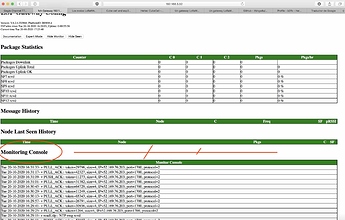Hello good afternoon, I know they will be very busy but they would help me a lot if they could review my problem,
I am trying to make the single channel gateway project to connect Lora with TTN using: Heltec WiFi LoRa v2 (gateway) and Cubecell hatch-ab01 (node) I have followed the instructions in the tutorial https://github.com/things4u/ESP-1ch-Gateway.
The gateway seems to be going well, although I don’t know if I also have to modify some parameter, I want it to communicate on frequency 868 and on channel 0.
But it doesn’t seem to communicate the node cubecell with the esp32.
the node code is this:
I have modified with respect to the original code
#define LED_BUILTIN 34 and add #include <LoRaWan_APP.h>
follow this post Cube cell and esp32 lora problems
LoRa sender for CubeCell code below
and LoRa receiver for WiFi LoRa 32(V2):
this is completed project https://anonfiles.com/pcVdK9hcp0/ESP-sc-gway-v6_zip
// Include the arduino-lmic library:
#include <lmic.h>
#include <hal/hal.h>
#include <SPI.h>
#include <LoRaWan_APP.h>
// Below sets the trigger for sending a new message to a gateway.
// Either or both can be enabled (in which case pressing the button will restart the timer)
#define SEND_BY_BUTTON 1 // Send a message when button “0” is pressed
#define SEND_BY_TIMER 1 // Send a message every TX_INTERVAL seconds
#define LED_BUILTIN 34 <------ LED PIN? = RGB
#define RF_FREQUENCY 868000000 // Hz
#define TX_OUTPUT_POWER 14 // dBm
#define LORA_BANDWIDTH 0 // [0: 125 kHz,
// 1: 250 kHz,
// 2: 500 kHz,
// 3: Reserved]
#define LORA_SPREADING_FACTOR 8 // [SF7…SF12]
#define LORA_CODINGRATE 4 // [1: 4/5,
// 2: 4/6,
// 3: 4/7,
// 4: 4/8]
#define LORA_PREAMBLE_LENGTH 8 // Same for Tx and Rx
#define LORA_SYMBOL_TIMEOUT 0 // Symbols
#define LORA_FIX_LENGTH_PAYLOAD_ON false
#define LORA_IQ_INVERSION_ON false
#define RX_TIMEOUT_VALUE 1000
#define BUFFER_SIZE 30 // Define the payload size here
// LoRaWAN NwkSKey, network session key
// This is the default Semtech key, which is used by the early prototype TTN
// network.
static const PROGMEM u1_t NWKSKEY[16] = { *************** };
// LoRaWAN AppSKey, application session key
// This is the default Semtech key, which is used by the early prototype TTN
// network.
static const u1_t PROGMEM APPSKEY[16] = { **************** };
// LoRaWAN end-device address (DevAddr)
static const u4_t DEVADDR = 0x***********;
// These callbacks are only used in over-the-air activation, so they are
// left empty here (we cannot leave them out completely unless
// DISABLE_JOIN is set in config.h, otherwise the linker will complain).
void os_getArtEui (u1_t* buf) { }
void os_getDevEui (u1_t* buf) { }
void os_getDevKey (u1_t* buf) { }
static uint8_t mydata[] = “Hello, world!”;
static osjob_t sendjob;
// Pin mapping for the SparkX ESP32 LoRa 1-CH Gateway
// CubeCell-GPS SX1262 pin mapping ???
const lmic_pinmap lmic_pins = {
.nss = 18,
.rxtx = LMIC_UNUSED_PIN,
.rst = 14,
.dio = {26, 35, 33},
};
// If send-by-timer is enabled, define a tx interval
#ifdef SEND_BY_TIMER
#define TX_INTERVAL 60 // Message send interval in seconds
#endif
// State machine event handler
void onEvent (ev_t ev) {
Serial.print(os_getTime());
Serial.print(": ");
switch (ev) {
case EV_SCAN_TIMEOUT:
Serial.println(F(“EV_SCAN_TIMEOUT”));
break;
case EV_BEACON_FOUND:
Serial.println(F(“EV_BEACON_FOUND”));
break;
case EV_BEACON_MISSED:
Serial.println(F(“EV_BEACON_MISSED”));
break;
case EV_BEACON_TRACKED:
Serial.println(F(“EV_BEACON_TRACKED”));
break;
case EV_JOINING:
Serial.println(F(“EV_JOINING”));
break;
case EV_JOINED:
Serial.println(F(“EV_JOINED”));
break;
case EV_RFU1:
Serial.println(F(“EV_RFU1”));
break;
case EV_JOIN_FAILED:
Serial.println(F(“EV_JOIN_FAILED”));
break;
case EV_REJOIN_FAILED:
Serial.println(F(“EV_REJOIN_FAILED”));
break;
case EV_TXCOMPLETE:
digitalWrite(LED_BUILTIN, LOW); // Turn off LED after send is complete
Serial.println(F(“EV_TXCOMPLETE (includes waiting for RX windows)”));
if (LMIC.txrxFlags & TXRX_ACK)
Serial.println(F(“Received ack”));
if (LMIC.dataLen) {
Serial.println(F(“Received “));
Serial.println(LMIC.dataLen);
Serial.println(F(” bytes of payload”));
}
#ifdef SEND_BY_TIMER
// Schedule the next transmission
os_setTimedCallback(&sendjob, os_getTime() + sec2osticks(TX_INTERVAL), do_send);
#endif
break;
case EV_LOST_TSYNC:
Serial.println(F(“EV_LOST_TSYNC”));
break;
case EV_RESET:
Serial.println(F(“EV_RESET”));
break;
case EV_RXCOMPLETE:
// data received in ping slot
Serial.println(F(“EV_RXCOMPLETE”));
break;
case EV_LINK_DEAD:
Serial.println(F(“EV_LINK_DEAD”));
break;
case EV_LINK_ALIVE:
Serial.println(F(“EV_LINK_ALIVE”));
break;
default:
Serial.println(F(“Unknown event”));
break;
}
}
// Transmit data from mydata
void do_send(osjob_t* j) {
// Check if there is not a current TX/RX job running
if (LMIC.opmode & OP_TXRXPEND) {
Serial.println(F(“OP_TXRXPEND, not sending”));
} else {
digitalWrite(LED_BUILTIN, HIGH); // Turn on LED while sending
// Prepare upstream data transmission at the next possible time.
LMIC_setTxData2(1, mydata, sizeof(mydata) - 1, 0);
Serial.println(F(“Packet queued”));
}
}
void setup() {
Serial.begin(115200);
// Set button pin as input
#ifdef SEND_BY_BUTTON
pinMode(0, INPUT);
#endif
// Configure built-in LED – will illuminate when sending
pinMode(LED_BUILTIN, OUTPUT);
digitalWrite(LED_BUILTIN, LOW);
// LMIC init
os_init();
// Reset the MAC state. Session and pending data transfers will be discarded.
LMIC_reset();
// Set static session parameters. Instead of dynamically establishing a session
// by joining the network, precomputed session parameters are be provided.
uint8_t appskey[sizeof(APPSKEY)];
uint8_t nwkskey[sizeof(NWKSKEY)];
memcpy_P(appskey, APPSKEY, sizeof(APPSKEY));
memcpy_P(nwkskey, NWKSKEY, sizeof(NWKSKEY));
LMIC_setSession (0x1, DEVADDR, nwkskey, appskey);
#if defined(CFG_eu868) // EU channel setup
// Set up the channel used by the Things Network and compatible with
// our gateway.
// Setting up channels should happen after LMIC_setSession, as that
// configures the minimal channel set.
LMIC_setupChannel(0, 868100000, DR_RANGE_MAP(DR_SF12, DR_SF7), BAND_CENTI); // g-band
#elif defined(CFG_us915) // US channel setup
// Instead of using selectSubBand, which will cycle through a sub-band of 8
// channels. We’ll configure the device to only use one frequency.
// First disable all sub-bands
for (int b = 0; b < 8; ++b) {
LMIC_disableSubBand(b);
}
// Then enable the channel(s) you want to use
//LMIC_enableChannel(8); // 903.9 MHz
LMIC_enableChannel(17);
#endif
// Disable link check validation
LMIC_setLinkCheckMode(0);
// TTN uses SF9 for its RX2 window.
LMIC.dn2Dr = DR_SF9;
// Set data rate and transmit power for uplink (note: txpow seems to be ignored by the library)
LMIC_setDrTxpow(DR_SF7, 14);
// Start job – Transmit a message on begin
do_send(&sendjob);
}
void loop() {
os_runloop_once();
#ifdef SEND_BY_BUTTON
if (digitalRead(0) == LOW) {
while (digitalRead(0) == LOW) ;
do_send(&sendjob);
}
#endif
}
thank you

